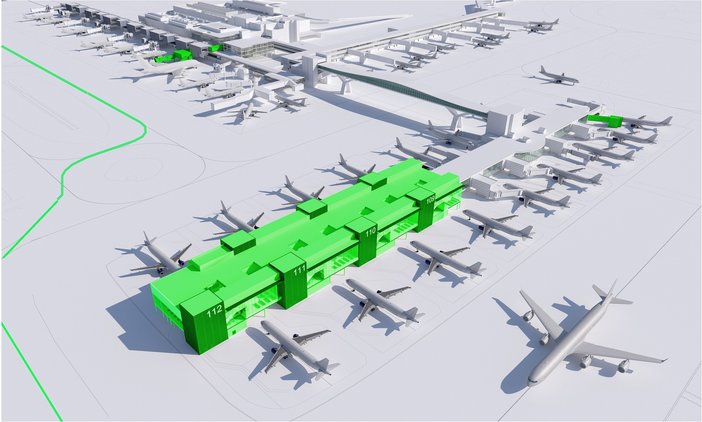London Gatwick Airport announced a new five-year Capital Investment Plan (CIP) at the British-Irish Airports Expo in London, UK, today (June 13), that will see the airport spend £1.11bn (US$1.48bn) up to 2023, with £266m (US$354m) planned for 2018/19 alone.
Gatwick expects to continue growing its long-haul operation and predicts that passenger numbers will increase to nearly 53 million by 2023. Since the airport changed ownership in December 2009, the total investment figure, combined with this new five-year plan, rises to £3.14bn (US$4.18bn).
Wide-ranging projects are identified across the airport, with many getting underway this year, including:
- Pier 6 Western Extension – Phase 1 works start with enabling Pier 5 to handle the A380 aircraft, so that it can move from its current home on Pier 6. This work will also involve the widening and reconfiguration of a taxiway to accommodate the 80m (262ft) wingspan of the A380.
- A new domestic arrivals facility, including a new baggage reclaim in South Terminal.
- A new mezzanine level extension in the North Terminal departure lounge to accommodate new restaurants.
- Completion of the road system and taxiway entrance to the new Boeing aircraft hangar to connect the airfield with the new facility. The new hangar opens next year and will service the growing number of long-haul aircraft operating from Gatwick.
- Trial of biometric auto-boarding technology in the North Terminal and extending the roll-out of self-service bag drop across both Terminals.
- Re-development of South Terminal hotel capacity.
- Completion of the South Terminal long-stay car park decking project, providing an additional 1,200 car parking spaces for summer 2018.
- Projects to support greater use of electric vehicles, continuing to reduce the airport’s environmental impact and supporting our ambition to be the UK’s most sustainable airport.
- Enabling works for Network Rail’s planned upgrade to the Gatwick station.
- Investment in joint equipment for ground handlers to use at Gatwick which drives efficiency for airfield and baggage operations.
- New reception center for passengers with reduced mobility in the North Terminal.
Commenting on the investment plans, Gatwick’s chief executive Stewart Wingate said, “Gatwick is a major piece of national infrastructure, and our continued growth and ability to attract long-haul airlines is vital for the health of the UK economy, particularly in a post-Brexit world.
“We are exploring ways to grow our capacity, including developing new systems and processes to handle more passengers, and considering how we use all our existing infrastructure in the future.
“By committing to spend another £1.11bn, Gatwick can continue to grow sustainably, attract new airlines and offer more global connections, while providing an excellent service to passengers.”
Gatwick has also identified several emerging projects which look to harness technology to further improve efficiency and service, such as:
- An integrated command and airport operations center to facilitate shared real-time operational awareness and management data between the airport, the airlines and their ground handlers.
- Robotic car parking, exploring the use of robots to park cars to offer efficient use of existing car park spaces through close-space parking.
- Smart taxiway lighting system to provide real-time directional airfield ground lighting to guide aircraft to and from the runway and parking stands.
The CIP is a rolling five-year plan which is published annually. This allows the CIP to be refreshed regularly as market conditions and operational needs change. It is published on the Gatwick website and can be found here.


